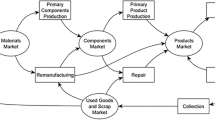Abstract
This paper characterizes equilibrium behavior in an auction where firms bid a unit price in order to fund and gain access to a new piece of infrastructure. Firms need access to this new infrastructure to sell their output in a competitive market. The new facility is built only if enough revenue is generated through the sale of access to the firms. We show by means of an example that this auction mechanism can dominate in terms of efficiency the standard mechanism where a uniform access price is determined ex-ante by a regulator.






Similar content being viewed by others
Notes
The analysis of the expansion of an existing line would be more complex, as it would require distinguishing between new and existing users, as the latter may already have paid for the existing infrastructure.
In the seminal paper, Laffont and Tirole (1994), authors examined the optimal pricing for accessing an existing facility under asymmetric information, and did not consider dynamic efficiency issues. Laffont and Tirole (1994, p. 1699) pointed out the static inefficiency of uniform access prices, as the sole regulatory instrument, in the presence of asymmetric information: ‘...a separation of regulatory and taxation mandates reduces the regulators’ number of instruments, and the access price must then arbitrate very imperfectly between the goals of limiting inefficient bypass and participating to the coverage of fixed costs. It is clear more generally that access pricing rules become more and more complex as well as inefficient as the regulator tries to use access prices, rather than complementary instruments, in order to meet various market structure goals such as inducing proper entry, reducing monopoly power in the competitive segment, or achieving distributional objectives.’ These authors recognized that they had not analyzed various dynamics issues, including investment in new facilities.
The implicit assumption here is that the regulator assigns zero weight in their objective function to any excess profits (that is, any revenue in addition to the cost of building the facility) earned by the facility owner. This is consistent with the general requirement for regulators to ensure that regulated firms do not earn monopoly profits.
We used both the Euler’s method and the Trapezoidal method to solve the system of differential equations numerically. However, the examples in this paper report the results of the Euler’s method. Also the initial condition used for this example is \(\alpha (1)=0\).
References
Agrell, P., & Kasperzec, R. (2010). Dynamic joint investment sin supply chains under information asymmetry. CORE discussion paper.
Agrell, P. J., & Bogetoft, P. (2016). Decentralization policies for supply chain investments under asymmetric information. Managerial and Decision Economics,. https://doi.org/10.1002/mde.2783.
Alboth, D., Lerner, A., & Shalev, J. (2001). Profit maximizing in auctions of public goods. Journal of Public Economic Theory, 3(4), 501–525.
Barbieri, S., & Malueg, D. A. (2008a). Private provision of a discrete public good: Continuous-strategy equilibria in the private-information subscription game. Journal of Public Economic Theory, 10(4), 529–545.
Barbieri, S., & Malueg, D. A. (2008b). Private provision of a discrete public good: Efficient equilibria in the private-information contribution game. Economic Theory, 37, 51–80.
Church, J. R., & Ware, R. (2000). Industrial organization: A strategic approach. Calgary: University of Calgary.
Crew, M. A., Fernando, C. S., & Kleindorfer, P. R. (1995). The theory of peak-load pricing: A survey. Journal of Regulatory Economics, 8(3), 215–248.
Garcia, A., & Shen, Z. (2010). Equilibrium capacity expansion under stochastic demand growth. Operations Research, 58(1), 30–42.
Hogan, W., Rosellón, J., & Vogelsang, I. (2010). Toward a combined merchant-regulatory mechanism for electricity transmission expansion. Journal of Regulatory Economics, 38(2), 113–143.
Laffont, J.-J., & Tirole, J. (1994). Access pricing and competition. European Economic Review, 38(9), 1673–1710.
Léautier, T.-O., & Thelen, V. (2009). Optimal expansion of the power transmission grid: Why not? Journal of Regulatory Economics, 36(2), 127–153.
Luss, H. (1982). Operations research and capacity expansion problems: A survey. Operations Research, 30(5), 907–947.
Martimort, D., & Moreira, H. (2010). Common agency and public good provision under asymmetric information. Theoretical Economics, 5, 159–213.
Menezes, F. M., Monteiro, P. K., & Temimi, A. (2001). Private provision of discrete public goods with incomplete information. Journal of Mathematical Economics, 34, 493–514.
Mieghem, J. A. V. (2003). Commissioned paper: Capacity management, investment, and hedging: Review and recent developments. Manufacturing & Service Operations Management, 5(4), 269–302.
QCA. (2013). Capacity expansion and access pricing for rail and ports. Discussion paper.
Schill, W.-P., Egerer, J., & Rosellón, J. (2015). Testing regulatory regimes for power transmission expansion with fluctuating demand and wind generation. Journal of Regulatory Economics, 47(1), 1–28.
Author information
Authors and Affiliations
Corresponding author
Additional information
Publisher's Note
Springer Nature remains neutral with regard to jurisdictional claims in published maps and institutional affiliations.
Appendix
Appendix
1.1 Proof of Proposition 1
Proof
The objective of the regulator is to set the optimal access fees \(\alpha _{i}^{*}\) and \(\alpha _{j}^{*}\) so that the facility is built whenever it is efficient to do so and to recover exactly the construction cost K. Therefore, the regulator maximizes the probability of completion, that is,
subject to the following three conditions,
Substituting from the last condition into the objective function for each \(\alpha \) and then differentiating gives the following first-order conditions.
Rearranging the above two terms would give Eqs. (3) and (4). \(\hfill\square \)
1.2 Proof of Corollary 1
Proof
When capacities are equal it is easy to check that both first order conditions becomes identical. That is the optimal access charges are the same. Then substituting equal access charges to the last condition, \(\alpha _{i}^{*}\bar{q}_{i}+\alpha _{j}^{*}\bar{q}_{j} =K\), gives \(\alpha _i = \alpha _j = \frac{K}{\bar{q}_{i}+\bar{q}_{j}}\). \(\hfill\square \)
1.3 Proof of Corollary 2
Proof
Substituting uniform distribution in the first-order conditions gives the above access charges. \(\hfill\square \)
1.4 Proof of Proposition 2
Proof
If both firm follow the same strategy in a symmetric equilibrium we have,
Equation (29) is not an ordinary differential equation and cannot be solved with standard computation methods. Thus, we proceed by transforming the differential equation given by Eq. (29) into two ordinary differential equations.
Then we can rewrite Eq. (29) as follows,
Because \((\alpha ^{-1})\big (\alpha (\psi (c))\big )=\psi (c)\), it is straightforward to show,
Thus the first-order condition becomes,
When \(\bar{q}_i=\bar{q}_j\) we have, \(\psi (c)= \alpha ^{-1} \big (\frac{K}{\bar{q}_i}-\alpha (c) \big )\). Define \(A=\frac{K}{\bar{q}_i}=\frac{K}{\bar{q}_j}\), then we have,
Using the same equation we can also write, \(A=\alpha (\psi (\psi (c))) + \alpha (\psi (c))\). Thus we have, \( \alpha (\psi (\psi (c))) = \alpha (c)\) or \( \psi (\psi (c)) = c\). Applying this to Eq. (32) results in
By differentiating Eq. (33) we get another equation as follows,
\(\hfill\square \)
1.5 Proof of Proposition 3
Proof
If \(\hat{p}-c_i\ge \frac{K}{2\bar{q}} \), then neither of the firms submit a bid less than \(\frac{K}{2\bar{q}}\), because according to the payment rule this guarantees the payoff of zero. If one firm follows \(\alpha ^*\), then the other firm’s best strategy is to also follow \(\alpha ^*\), because bidding more does not change the probability of completion while reduces the profit and bidding less guarantees zero. Thus, \(\alpha ^*\) is an equilibrium.
Now if a firm submits a bid equal to \(\frac{K}{2\bar{q}}\) then it must be the case with \(\hat{p}-c_i \ge \frac{K}{2\bar{q}} \), otherwise it is better off by not bidding. \(\hfill\square \)
Rights and permissions
About this article
Cite this article
Khezr, P., Menezes, F.M. Funding natural monopoly infrastructure expansion: auctions versus regulated uniform access prices. J Regul Econ 55, 193–213 (2019). https://doi.org/10.1007/s11149-019-09382-z
Published:
Issue Date:
DOI: https://doi.org/10.1007/s11149-019-09382-z




